|
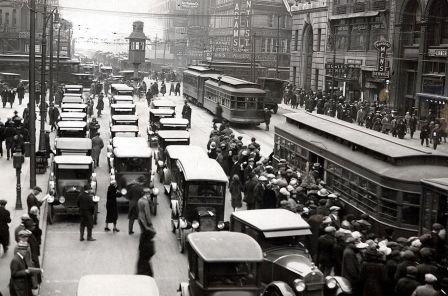
The Roaring Twenties
|
Roaring Twenties Facts for kids: Fast Fact Sheet
Fast, fun facts and Frequently Asked Questions (FAQ's)
about the Roaring Twenties.
What was the Roaring Twenties? The Roaring Twenties
was the period following the end of WW1 when
Americans wanted to enjoy their new
prosperity and have fun. The era ended with
the Great Depression of 1929.
Why was it called the Roaring Twenties?
It was called the Roaring Twenties to
reflect the exuberant era of prosperity and
revelry typified by the roaring of massive
numbers of automobiles that filled the
crowded city streets, the noisy mass
production methods in the factories and
industries and the sound of jazz music in
the speakeasies and the radio.
Who were the presidents during the
Roaring Twenties?
The Roaring Twenties
spanned the years from the end of WW1 in 1918 to the 1929
Great Depression. The second half of the decade becoming known as the
“Golden Twenties“. The presidents during the Roaring Twenties were Woodrow
Wilson (1913 - 1921), Warren Harding (1921-1923), Calvin Coolidge
(1923-1925 & 1925-1929) and Herbert Hoover (1929-1933).
What caused the Roaring Twenties?
The period in American history referred to
as the Roaring Twenties was caused by the aftermath of World War One
when young people wanted to forget the horrors of the war and enjoy
life again. Women had gained a new level of independence, were
attending college, earning wages and had been given the right to
vote. Women and the young men of the 1920's were challenging
traditional values and exchanging them for modern ideas. Lifestyles
had changed from rural country living to the fast urban lifestyle of
the crowded cities. America was beginning to prosper and new
technology, mass production and labor saving devices gave Americans
more time for leisure which they spent at the movies, dance clubs
and great sporting events. Automobiles were sold in their millions
and Americans roared around in their new vehicles. All of these
contributed to the causes of the Roaring Twenties.
Roaring Twenties
Facts for kids: A - Z of the Roaring Twenties
There were so many
elements in American life and lifestyles that were impacted by the
Roaring Twenties that we have provided an A- Z fact sheet containing
summaries, definitions and descriptions on each of the
subjects. For additional facts and info see
The Jazz Age.
Roaring Twenties
Facts for kids
-
A - Z
Facts
about the Roaring Twenties for kids
The following A- Z fact
sheet contains interesting facts and information on Roaring Twenties
for kids.
A - Z
Facts
about the Roaring Twenties for kids
Roaring Twenties Fact 1:
Airplanes: Flight technology
advanced significantly during WW1.The airline industry
received a boost in the Roaring Twenties with the
passage of the
1926 Air Commerce Act which provided
government aid for building new airports. In 1927
Charles Lindbergh gained international fame as the first
pilot to fly solo and non-stop across the Atlantic Ocean
in the "Spirit of Saint Louis". The emerging
aircraft industry produced 4600 American airplanes in
1928 and passenger terminals were built with comfortable
waiting-rooms. Refer to
Charles Lindbergh
Transatlantic Flight
Roaring Twenties Fact
2: Architecture: The style of
architecture was called Art Deco that featured strong
geometric shapes. The most famous building featuring the
Art Deco design was the Chrysler Building. Architecture
styles also reflected the Age of steel and the building
of new skyscrapers complete with elevators and
escalators. In residential home building the Roaring
Twenties architecture was characterized by improved
standards such as indoor plumbing and electric lighting.
Roaring Twenties Fact
3: Art and Artists: The art movements in the 1920's
were Surrealism and
Impressionism. Art Deco was also an art style of the
1920's, that also effected
architecture. Art Deco used strong colors and geometric
shapes to convey the "modern" look. Art Deco also used
sleek, streamlined forms to convey elegance and
sophistication. Creative European artists such as
Picasso, Cezanne and Salvador Dali influenced the work
of American artists such as Edward Hopper, John Marin
and Charles Scheeler.
Roaring Twenties Fact
4: Baseball: Baseball became a
popular spectator sport in the Roaring Twenties. The
Yankee Stadium was built in the Bronx, New York and in
1927 Babe Ruth hit 60 home runs.
Roaring Twenties Fact
5: Books: The books that defined
the period of the Roaring Twenties included The Great
Gatsby by F. Scott Fitzgerald, Strange Interlude by
Eugene O'Neill, The Sun Also Rises & A Farewell to Arms
by Ernest Hemingway, The Sound and the Fury by William
Faulkner, The Waste Land by T.S. Eliot and Their Eyes
Were Watching God by Zora Neale Hurston.
Roaring Twenties Fact
6: Cars and Automobiles: In
October 1908
Henry Ford created the Model T which was much cheaper than other cars because
it was made on an assembly line using mass
production techniques. The Model T automobile revolutionized
transportation and allowed many Americans to buy cars
- by 1927 Ford had sold 15 million Model T automobiles
that revolutionalized the American way of life. The
effects of the automobile industry were huge and led to
the building of new roads and highways, service
stations, expressways, garages and motels during the
Roaring Twenties.
Roaring Twenties Fact
7: Communism: The hatred and
suspicion in WW1 spilled over into the Red Scare and the
fear of anarchists, extreme socialists and the
infiltration of Unions by Marxists and communists. The
fear of communism in the United States would have a
long-reaching effect on the country.
Roaring Twenties Fact
8: Consumerism: Consumerism is
the theory that it is economically desirable to
encourage the acquisition of goods and services in
ever-greater amounts. Consumerism increased during the
Roaring Twenties due to the technical advances in the
areas of communication, transportation,
industrialization and manufacturing. Americans moved
from the traditional practice of thrift and the
avoidance of debt to the "Live now, pay later" concept
by buying goods on credit installments. Mass advertising
via the media and the radio increased sales via easy
consumer credit. Over 60% of Americans bought their
automobiles on credit in the Roaring Twenties. For
additional facts refer to
Consumerism in 1920's America
Roaring Twenties Fact
9: Dance: The new type of music
called jazz developed in the United States, and inspired
new, crazy dance moves. New dances evolved in the
Roaring Twenties including the Charleston, the Black
Bottom, the Shimmy, Turkey trot, Cake walk, Bunny hop,
the Lindy Hop and the American Tango. The old dances
such as the waltz and the foxtrot were also
popular.
A new phenomenon known as Marathon dances also
swept the country.
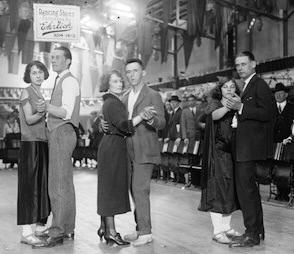
Roaring Twenties Fact
10: Economy: The United States
moved from the war economy and businesses moved on from
supplying military needs to making commercial products.
After an initial recession, middle class Americans moved
to a period of economic expansion and prosperity.
Between 1921 and 1924 the nation’s gross national
product jumped from $69 billion to $93 billion whilst
wages rose by 22% from roughly $36.4 billion to $51.5
billion.
Roaring Twenties Fact
11: Electricity: Most industries
switched from coal power to electricity in the Roaring
Twenties and most homes, especially in the towns and
cities were lit by electricity. Access to electricity
provided Americans with the power required to run new
labor saving appliances such as refrigerators, washing
machines, electric razors, vacuum cleaners, electric
irons, radios and gramophones.
Roaring Twenties Fact
12: Entertainment: Pleasure and
entertainment in the Roaring Twenties offered an
exciting variety of leisure pursuits. People went to the
movies, the theatre, clubs, and the massive sports
stadiums, The radio provided entertainment at home
bringing music, news broadcasts, drama and comedy to
American houses on a daily basis. People were fascinated
by airplanes and flight and 'barnstormers' toured the
nation offered flights and displays which included the
daredevil 'wing-walkers of the Roaring Twenties.
Continued...
A - Z
Facts
about the Roaring Twenties for kids
Facts
about the Roaring Twenties for kids
The following A - Z fact
sheet continues with facts about Roaring Twenties for kids.
A - Z
Facts
about the Roaring Twenties for kids
Roaring Twenties Fact
13: Farmers: The farms and farmers
did not share in the prosperity of the nation during the
Roaring Twenties. There were some technical advances
which helped to increase production but demand remained
static and prices of farm produce fell and wages
dropped. 6 million farmers left rural life for the
cities during the Roaring Twenties.
Roaring Twenties Fact
14: Fashion and clothing: Men wore
well-tailored pinstriped suits, silk shirts and
handkerchiefs, trilby hats, suspenders, bow ties, black patent
leather shoes and spats. The fashion and clothing for
men also included short suit jackets, cuffed trousers or
wide-leg "Oxford Bags", vests (waistcoats) and sports influenced
attire like sweaters and knickerbockers. Women's fashion included
Fringed Beaded Flapper dresses with pleats and gathers, short skirts with a
hemline above the knee, cloche hats and they wore their hair cut
short in a bob.
Accessories included long strands of pearl beads,
cigarette holders, feather headbands and boas.
Their silk, woolen or rayon stockings were held up by
garters. New fashion and clothing was influenced by the
Art Deco designs of the era and popularized by the media and the
famous movie stars. Refer to
1920's Fashion for Women
Roaring Twenties Fact
15: Flappers: Flappers were
light-hearted, female nonconformists who were eager to
try new styles of dress and challenged the traditional
ideas of behavior by wearing make-up, drinking and smoking in public and
acting in an unladylike fashion.
Flappers wore short
bobbed hair, make-up such as lipstick and rouge, short
fringed skirts, bright-colored sweaters and scarves
illustrated in the picture of Clara Bow - The "It Girl".
Famous Flappers of the Roaring Twenties were
Clara Bow, movie star
Joan Crawford and Zelda Fitzgerald, the wife of F. Scott
Fitzgerald.
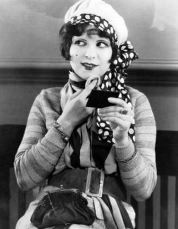
Roaring Twenties Fact
16: Fundamentalism: Many
Protestant Americans feared the country was losing its
traditional religious values and morals which gave rise
to the Fundamentalist movement and passionate
evangelists such a Aimee Semple McPherson and Billy
Sunday. The views of John T. Scopes on evolution enraged
Fundamentalists and led to his arrest and trial.
Roaring Twenties Fact
17: Gangsters: The
Prohibition Gangsters
were violent mobsters who extended their
illegal activities in the 1920's through the
sale of intoxicating liquor which led to the
rise of organized crime. The names of the most famous
gangsters in the Roaring Twenties were
Al "Scarface" Capone, George “Bugs” Moran, Charles
“Lucky” Luciano, Dutch Schultz and Jack "Legs" Diamond.
Roaring Twenties Fact
18: Great Gatsby: F. Scott
Fitzgerald published The Great Gatsby in 1925 which told
the story of the fictional character Jay Gatsby and
exposed the excesses of consumerism during the 1920s.
Roaring Twenties Fact
19: Hairstyles: The most
popular hairstyles for men were the "patent-leather
hair" style that was parted on the side, or in the
middle, and slicked down close to the head. The most
popular Roaring Twenties hairstyles for women were the
straight, short style, cut in a bob.
Roaring Twenties Fact
20: Harlem Renaissance: Harlem
Renaissance was the African-American artistic and
literary culture that was developed in the 1920's. The
WW1 Great Migration
saw the movement of African
Americans from the southern farmlands to the northern
cities. The New York city neighborhood of Harlem was the
home of the Harlem
Renaissance and influenced African
American authors, artists and musicians.
The Cotton Club
was the most famous Harlem night spot and musicians such
as Louis Armstrong and Duke Ellington played the
Dixieland music, the blues and the improvisational style
of music called Jazz.
The painting is by
F. Winold Reiss and entitled "Interpretation of Harlem
Jazz"
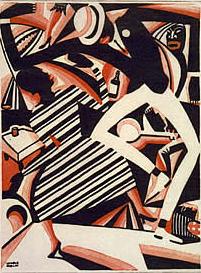
Roaring Twenties Fact
21: Hollywood: Located near Los
Angeles in California, Hollywood was the ideal place for
outdoor filming. 85% of U.S. movie production was made
in or around Hollywood see
Hollywood in the
1920s. The major movie companies in
Hollywood during the Roaring Twenties era were Warner
Brothers, Paramount, MGM and United Artists. At
the end of the era Hollywood were producing over 500
movies each year.
Roaring Twenties Fact
22: Immigration: After WW1
US Immigration polices and laws changed. The
1921 Emergency
Quota Act and the
Immigration Act of 1924
limited immigration by restricting the number of
immigrants from a given country.
Roaring Twenties Fact
23: Inventions: New Roaring
Twenties inventions included washing machines,
refrigerators, vacuum cleaners, radios, automobiles.
pop-up toasters, the 'talkies', phonographs and records.
Roaring Twenties Fact
24: Isolationism: Following
European entanglement during WW1 Americans favored the
policy of
Isolationism and wanted to be left alone to
enjoy the post-war prosperity of the nation.
Roaring Twenties Fact
25: Jazz Age: The Jazz Age,
another name used for the Roaring Twenties, became
associated with modernism, sophistication and decadence.
Roaring Twenties Fact
26: Jazz and Jazz Musicians: Louis
Armstrong is credited with putting Jazz on the musical
map. Famous Jazz musicians and personalities of the era
included Louis "Satchmo" Armstrong, Dizzie Gillespie,
Ella Fritzgerald, Thelonious Monk, Josephine Baker,
Fletcher Henderson, Bessie Smith "the Empress of the
Blues & Jazz", Duke Ellington.
Roaring Twenties Fact
27: KKK - Ku Klux Klan: The
Resurgence of the 1920's Ku Klux
Klan followed WW1 when they were portrayed as the
protectors of traditional values and opposers of
immigration.
The Second KKK attracted
millions of new members and 40,000 Klansmen famously
marched through Washington filling Pennsylvania Avenue
on August 8, 1925.
At its peak in the 1920s, Ku Klux
Klan membership exceeded 4 million people nationwide.
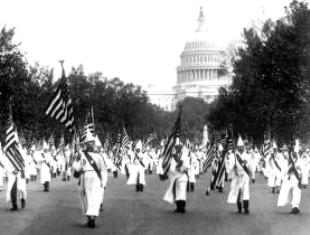
Roaring Twenties Fact
28: Lifestyle: F. Scott
Fitzgerald's novel "The Great Gatsby" illustrated the
lifestyle of young people during the Roaring Twenties.
Established traditions were challenged. Some chose
extreme unconventional, Bohemian lifestyles and
congregated in places such as Greenwich Village and
Chicago's south side. Lifestyle was significantly
effected by the availability of labor saving products,
luxury items and the emergence of mass advertising
campaigns and Consumerism.
Roaring Twenties Fact
29: Literature: American authors,
playwrights and poets challenged traditional ideas and
reflected modern life and the impact of modernism in the
literature of the Roaring Twenties. Literature reflected
realistic characters and themes and many authors
disillusioned by the Great War concentrated on the
negative effects of modernism. The famous authors of the
period included F. Scott Fitzgerald, Ezra Pound, Eugene
O'Neill, Ernest Hemingway, Langston Hughes, William
Carlos Williams, Amy Lowell, Sinclair Lewis, William
Faulkner, T.S. Eliot and Zora Neale Hurston.
Roaring Twenties Fact
30: Make-up: Prior to the Roaring
Twenties era make-up and cosmetics were not accepted in
American society as it was associated with loose living
and prostitution. In the Roaring Twenties women often
copied the make-up used by movie stars such as Joan
Crawford and Clara Bow and the celebrity flappers whose
photo's were featured in newspapers. They plucked their
eyebrow, used eye pencil and applied kohl to their
eyelashes, used lipstick and applied face powder and
rouge (they also applied rouge to the knees!).
Roaring Twenties Fact
31: Mass Production: Mass
Production techniques in industries and factories
enabled massive quantities of products to be produced
quickly and efficiently by an automated, mechanical
process and reduced consumer costs. Mass Production
techniques in the Roaring Twenties included the
efficient use of the Assembly Line, as used by Henry
Ford and the production of the Model T automobile.
Roaring Twenties Fact
32: Modernity: The spirit of the
era embraced Modernity in which new inventions and the
latest technology developed in the Roaring Twenties
increased the impulse to break with tradition and try
anything that was modern.
Roaring Twenties Fact
33: Morals: Many Americans
believed that the morals of the nation were in sharp
decline in the Roaring Twenties. People smoked
cigarettes, drank prohibited liquor, used slang, enjoyed
wild dances and women dressed in attire considered by
many as too revealing. Birth-control devices became
available introducing an element of sexual freedom.
Roaring Twenties Fact
34: Movies: Cinema started with
silent, black and white movies of the early 1920's that
were accompanied by music played on a piano or organ. In
1922 the first all-color movie called 'Toll of the Sea'
was released. The first movie with sound effects and
music, called Don Juan, was made by Warner Bros. Charlie
Chaplin's popular silent comedy The Gold Rush premiered
on August 16, 1925. The 'talkies' started in 1927 when
Al Jolson starred in 'The Jazz Singer' -
First talking movie -
The Jazz Singer. Walt Disney's
Steamboat Willie premiered on November 18, 1928,
introducing the world to Mickey Mouse. The Roaring
Twenties movies were a cheap form of entertainment and
by 1929 an average of 100 million Americans went to the
cinema on a weekly basis. By the end of the Roaring
Twenties there were 25,000 cinemas.
Roaring Twenties Fact
35: Music: Jazz, ragtime and the
music from Broadway musicals dominated the era (also
refer to Jazz).
Louis Armstrong
was one of the most popular Jazz musicians of the era
and played his famous solo's in the nightclubs of
Chicago.
Popular songs of the era included “Baby
Face”, “I Want to Be Happy”, “Blue Skies”, “Crazy
Rhythm”, “Charleston” and “Singin’ in the Rain”.
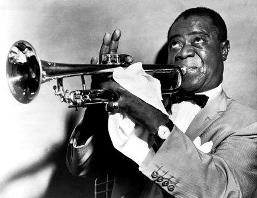
Roaring Twenties Fact
36: Nativism: Propaganda in WW1
led to a widespread distrust of Germans and other
foreigners, strong opposition to immigration and a
resurgence of
Nativism in America.
Roaring Twenties Fact
37: New Morality: Traditionalists
feared that the ' New Morality' of the Roaring Twenties
period was taking over the nation threatening family
values and the traditional role of women in the home.
The personal freedom and new ideas craved by the youth
culture added to the fears.
Roaring Twenties Fact
38: New Woman: The 'New Woman' had
been given the right to vote in the 19th Amendment
passed in 1920. The 'New Woman' could attend college,
get a career or a job and her wages gave her
independence. Women were clamoring to learn how to drive
which gave them a new-found freedom. Many women
challenged the traditional, ideas about the role of
women and a generation gap began to form between the
'New Women' and the older generation . The confines of
the old style clothing with long skirts and restrictive
corsets were thrown aside for the new, modern fashions
as worn by the Roaring Twenties 'Flappers'.
Roaring Twenties Fact
39: Organized Crime: The National Crime Syndicate was the
name given by the press to the organized crime syndicate
established by Al Capone which later became
known as Murder, Inc. The Chicago Mafia headed by Al
"Scarface" Capone were part of the organized crime wave
that escalated during Prohibition in the Roaring
Twenties.
Roaring Twenties Fact
40: Prohibition: In the
Prohibition Era the manufacture
and sale of alcohol was banned, was instituted with
ratification of the 18th Amendment and enacted by the
Volstead Act. Prohibition opened the nation to
unintended consequences such as bootlegging,
speakeasies, gangsters, corruption and the rise of
organized crime.
Roaring Twenties Fact
41: Radio: Radio was the first
mass broadcasting medium that drew the nation together
by breaking down provincialism. The Roaring Twenties
radio programs spread modern ideas and brought news,
music entertainment, and advertisements to millions of
listeners. The first commercial radio station, KDKA,
went on the air on November 2, 1920. By 1922 there were
500 radio stations in America and by the end of the
1920s there were over 100 million radios in use. The
popular radio shows of the 1920's included Amos
‘n’ Andy. For more facts refer to
1920's Radio and Advertising.
Roaring Twenties Fact
42: Red Scare: The Roaring
Twenties started following a wave of strikes in 1919
that helped to fuel fears that Communists, or “reds” and
anarchists were conspiring to start a revolution in the
America. This fear led to a nationwide panic known as
the Red Scare.
Roaring Twenties Fact
43: Shoes: Various shoes were in
fashion such as the low-heeled “finale hopper” shoes and
the high
overshoes, or galoshes. Men wore patent leather shoes
and spats.
Roaring Twenties Fact
44: Speakeasies: Speakeasies were saloons or
nightclubs that sold alcoholic beverages illegally during the period
of Roaring Twenties Prohibition. Speakeasies (speak-easies) were so
named because patrons had to whisper code words to enter the illegal
drinking clubs. Speakeasy clubs claimed to sell soft drinks, but
served alcohol behind the scenes.
Roaring Twenties Fact
45: Sports: Madison Square Garden
was rebuilt in 1925 in order to hold sporting events
such as boxing, ice hockey and basketball. The Yankee
Stadium was built in 1927 for baseball. Sports fans
could also listen to live sports events on the radio.
In October 1921 Baseball's World Series was broadcast on
radio for the first time when the New York Giants
defeated the New York Yankees. Professional football
began during the 1920s. Roaring Twenties Sporting heroes
included Jack Dempsey, Gene Tunney, Johnny
Weissmuller, Knute Rockne, Babe Ruth and 'Red' Grange.
Roaring Twenties Fact
46: Terms and Phrases: Terms and
Phrases that emerged during the era were flappers,
speakeasies, jazz, hooch, big cheese, jazzbos,
bootlegger, Reds, cat's whiskers, the bee's knees,
gatecrasher, crush, scram, lounge lizards, stool
pigeons, tommy guns and 'Dirty rats'.
Roaring Twenties Fact
47: Urbanization: For the first
time in history more people lived in the cities than in
rural, farming areas.
Urbanization in America brought with it both
problems and benefits to city living. Urbanization was
fueled by the
Industrial
Revolution and the
advances of
Industrialization.
Roaring Twenties Fact
48: Xenophobia: The rise in
xenophobia (the irrational fear of foreigners or
strangers) led to racism, ethnic conflict and the belief
in the inherent superiority of one culture based on
judgmental comparisons to different, alien cultures
(ethnocentrism). The rise in Roaring Twenties xenophobia
was used by the KKK to attract hundreds of thousands of
new members.
Roaring Twenties Fact
49: Youth: The youth of the era
enjoyed the freedom that the automobiles gave. They were
able to travel away from the confines of the family and
grasp the new job opportunities that the period had to
offer.
They learnt the crazy and frenetic dances such as
the Charleston and the Black Bottom, and wore the
radically new styles of fashion and clothing. Leisure
time was spent in dance clubs, at the 'talkies' or at
various sporting events.
The
1920's Radio, records and
gramophones increased the popularity of listening to
jazz.
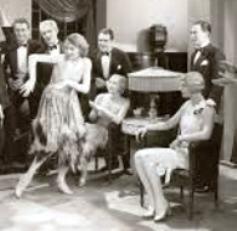
Roaring Twenties Fact
50:
WW1: WW1 ended on November 11, 1918. People
wanted to forget the horrors of the Great War and have
some fun. Young people questioned religion, morals and
traditions leading them to try new lifestyles. New
production techniques such as mass production and the
assembly line had been introduced for the war effort and
these innovative ideas were transferred to industry.
A - Z
Facts
about the Roaring Twenties for kids
1920's
Roaring Twenties
Facts for kids: List of Names of
Famous
People in the Roaring Twenties
Famous people: The famous people of the era came from
all walks of life. Many obtained celebrity through the movies,
radio, music, sports, literature and press coverage. The names of
some of the most famous people are detailed below:
List of Names of
Famous
People in the Roaring Twenties for kids Al "Scarface"
Capone ● F. Scott
Fitzgerald ● Charles
A. Lindbergh ● Langston
Hughes ● Duke
Ellington ● Louis
Armstrong ● Babe Ruth ● Helen
Wills ● Clara Bow ● Al Jolson ● Marcus
Garvey ● Jay
Gatsby ● Zora
Neale Hurston ● Charlie
Chaplin ● J. Edgar
Hoover ●
George “Bugs” Moran ● William
Randolph Hearst ● Coco
Chanel ● Josephine
Baker ● George
Gershwin ● Billy
Sunday ● Aimee
Semple McPherson ● John T.
Scopes ● Rudolph
Valentino ● Mary
Pickford ● Douglas
Fairbanks ● Gloria
Swanson ● Buster
Keaton ● Joan
Crawford ● Jack
Dempsey ● Gene
Tunney ● 'Red'
Grange. ● Amelia
Earhart ● Johnny
Weissmuller ● Knute
Rockne ● Mae West ● Langston
Hughes ● Walt
Disney ● Amy
Lowell ● Dizzie
Gillespie
List of Names of
Famous
People in the Roaring Twenties for kids
Facts
about
Roaring Twenties for kids
For visitors interested in the history of
the Roaring Twenties refer to the following articles:
1920's
Roaring Twenties
Facts for kids: A-Z Subjects relating to the Roaring
Twenties Era
We identified 50 important subjects about the
Roaring Twenties Era. A - Z order: Airplanes,
Architecture, Art and Artists, Baseball, Books, Cars
and Automobiles, Communism, Consumerism, Dance,
Economy, Electricity, Entertainment, Farmers,
Fashion, Flappers, Fundamentalism, Gangsters, Great
Gatsby, Hairstyles, Harlem Renaissance, Hollywood,
Immigration, Inventions, Isolationism, Jazz Age,
Jazz and Jazz Musicians, KKK - Ku Klux Klan,
Lifestyle, Literature, Make-up, Mass Production,
Modernity, Morals, Movies, Music, Nativism, New
Morality, New Woman, Organized Crime, Prohibition,
Radio, Red Scare, Shoes, Speakeasies, Sports, Terms
and Phrases, Urbanization, Xenophobia, Years, Youth
and WW1.
Roaring Twenties for kids
The article on the
Roaring Twenties provides
detailed facts and a summary of the most important events and dates in the history of the
United States
- a crash course in
American History. The following video will
give you additional important facts, history and dates about the
personal and political lives of all the US Presidents.
A- Z of the Roaring Twenties
●
Interesting Facts about Roaring Twenties for kids and schools
●
Key events
and Roaring Twenties for kids
●
The Roaring Twenties, an important period in US history
●
50 important topics of the Roaring Twenties
●
Fast, fun facts about the Roaring Twenties
●
All you need to know about the Roaring Twenties
● Fifty Fast, Fun Facts about the
Roaring Twenties for schools,
homework, kids and children |